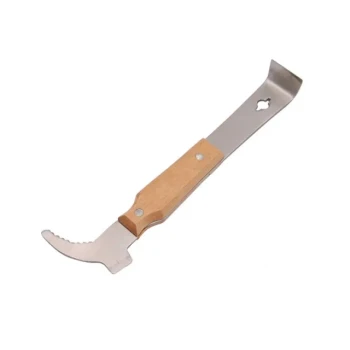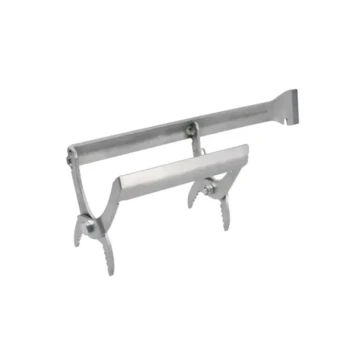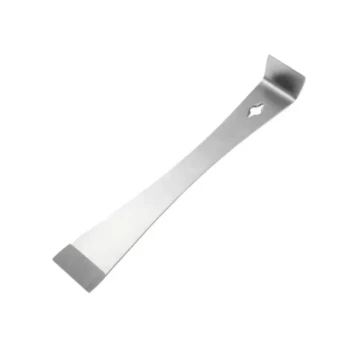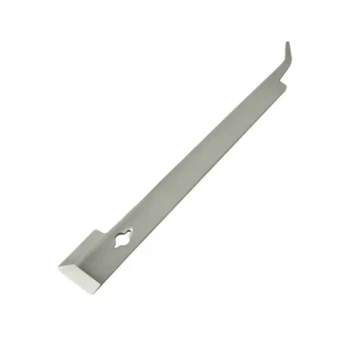In short, a top bar hive helps control varroa mites through two main principles. Its design encourages bees to build smaller, natural-sized brood cells, which can physically inhibit mite reproduction. Many designs also incorporate a screened bottom board that allows mites to fall out of the hive permanently, breaking their life cycle.
A top bar hive is not a "mite-proof" solution but rather a system that aids a colony's natural defenses against varroa. It reduces mite pressure but does not eliminate the beekeeper's critical responsibility to actively monitor and manage infestation levels.

How Design Features Inhibit Varroa Mites
A top bar hive's structure creates an environment that is less favorable for varroa mites compared to conventional hives. This is achieved through specific features that work passively to reduce the mite population.
The Theory of Natural Cell Size
In a top bar hive, bees build their comb naturally from a single wooden bar without foundation. This results in comb with smaller, "natural-sized" cells.
The theory is that this smaller cell provides a tighter fit for the developing bee pupa. This snug environment can physically disrupt the varroa mite's reproductive cycle, as the mother mite may have less space to move, feed, and lay her own eggs.
The Role of a Screened Bottom Board
Many top bar hive designs include a wire mesh or "screened" bottom board. This is a simple but effective mechanical control.
Varroa mites occasionally fall off their host bees. With a screened floor, these mites fall completely out of the hive. They cannot climb back up through the mesh, which effectively removes them from the colony and reduces the overall mite population.
Beekeeper Intervention is Still Essential
While these design features are beneficial, they do not eliminate the threat of varroa mites. Relying solely on the hive's design for mite control is a common and often fatal mistake for the colony.
It's an Aid, Not a Cure
The hive's passive controls help to reduce mite pressure, not eliminate it. They are best viewed as part of a holistic, integrated pest management (IPM) strategy.
A strong, healthy colony in a top bar hive is better equipped to manage a low mite load, but a large infestation will still overwhelm and kill the colony without intervention.
The Necessity of Active Monitoring
The beekeeper's primary role is to monitor the hive's health. This means regularly checking varroa mite levels through methods like sugar rolls or alcohol washes.
Failing to monitor gives you a false sense of security. Knowing the actual mite count is the only way to determine if and when more direct intervention is required to save the colony.
Understanding the Pitfalls
Adopting a top bar hive for its varroa management benefits requires a clear understanding of the limitations and potential for misplaced confidence.
The Cell Size Debate
While the natural cell size theory is a popular concept in natural beekeeping, its overall effectiveness is a subject of debate. It should be considered a minor contributing factor, not a primary defense.
Environmental factors, bee genetics, and overall colony health have a much greater impact on varroa resistance than cell size alone.
The Risk of Over-Reliance
The single greatest pitfall is assuming the hive does all the work. Beekeepers who believe a top bar hive makes them immune to varroa problems often fail to act until an infestation is uncontrollable.
This "hands-off" belief is the primary reason colonies in these hives are lost to mites, not a failure of the hive design itself.
How to Apply This to Your Mite Strategy
Your approach should align with your beekeeping goals while acknowledging the biological reality of the varroa mite.
- If your primary focus is a low-intervention, natural system: The top bar hive is an excellent choice that supports bee health, but you must pair it with a rigorous commitment to monitoring mite levels.
- If your primary focus is ensuring colony survival above all: Use the top bar hive's passive controls as your first line of defense, but be fully prepared to intervene with appropriate treatments if monitoring shows mite populations are rising.
Ultimately, a top bar hive provides useful tools for varroa management, but the beekeeper's knowledge and active involvement remain the most critical factors for colony health.
Summary Table:
| Top Bar Hive Feature | How It Helps Control Varroa Mites |
|---|---|
| Natural Cell Size | Creates a tighter fit for bee pupae, potentially disrupting the mite's reproductive cycle. |
| Screened Bottom Board | Allows fallen mites to exit the hive permanently, reducing the overall population. |
Ready to strengthen your apiary's natural defenses?
At HONESTBEE, we supply commercial apiaries and beekeeping equipment distributors with the durable, well-designed tools needed for successful integrated pest management. A top bar hive is just one part of a holistic strategy. Let our wholesale-focused experts help you equip your operation for healthier, more resilient colonies.
Contact our team today to discuss your beekeeping supply needs.
Visual Guide
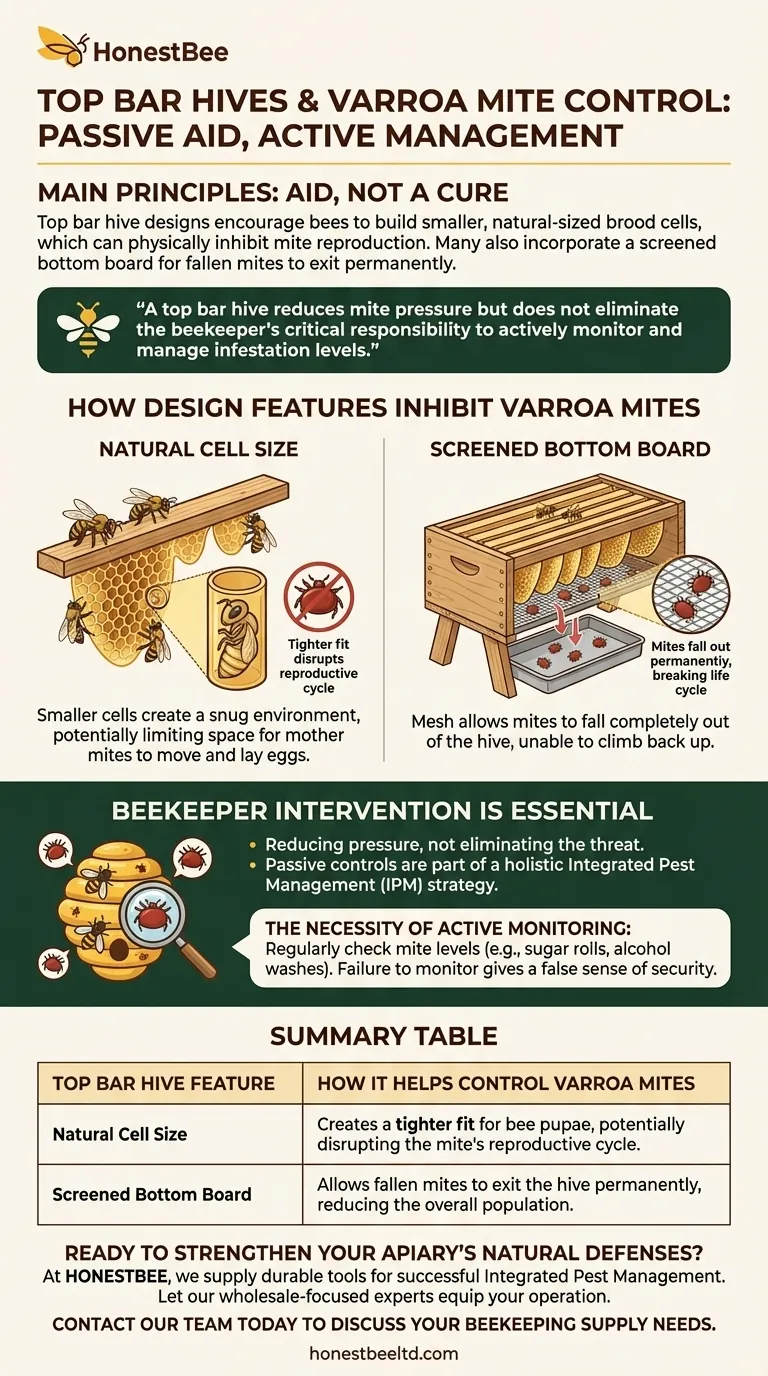
Related Products
- Long Langstroth Style Horizontal Top Bar Hive for Wholesale
- Langstroth Bee Hives Bee Keeping Box for Beginners Beekeeping
- HONESTBEE Professional Long Handled Hive Tool with Precision Cutting Blade
- HONESTBEE Professional Multi-Functional Hive Tool with Ergonomic Wood Handle
- HONESTBEE Advanced Ergonomic Stainless Steel Hive Tool for Beekeeping
People Also Ask
- What are the most popular types of hives besides the Langstroth? Top Bar & Horizontal Hives Explained
- What are the main differences between Langstroth hives and top bar hives? Choose the Right Hive for Your Beekeeping Goals
- What is a top bar bee hive? A Natural, Low-Stress Beekeeping Solution
- What are the benefits of the top bar hive? A Guide to Ergonomic, Natural Beekeeping
- How does the design of a top bar hive benefit beekeepers? Ergonomic & Natural Beekeeping for Hobbyists



